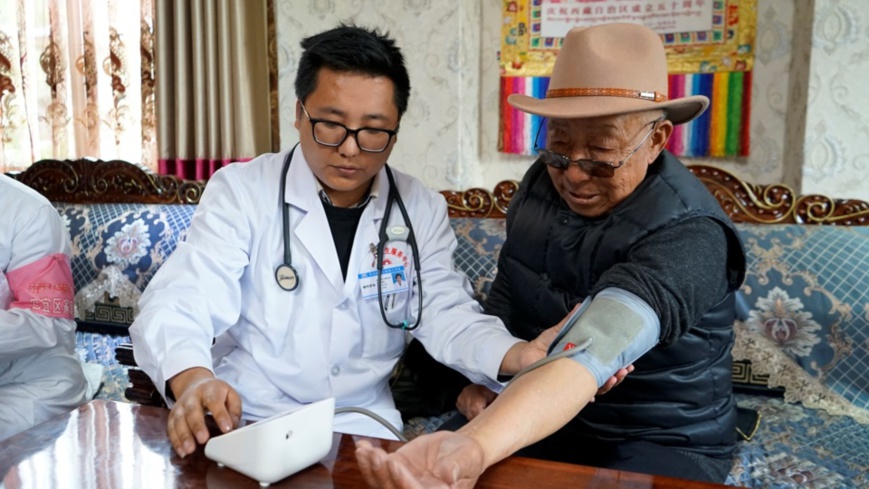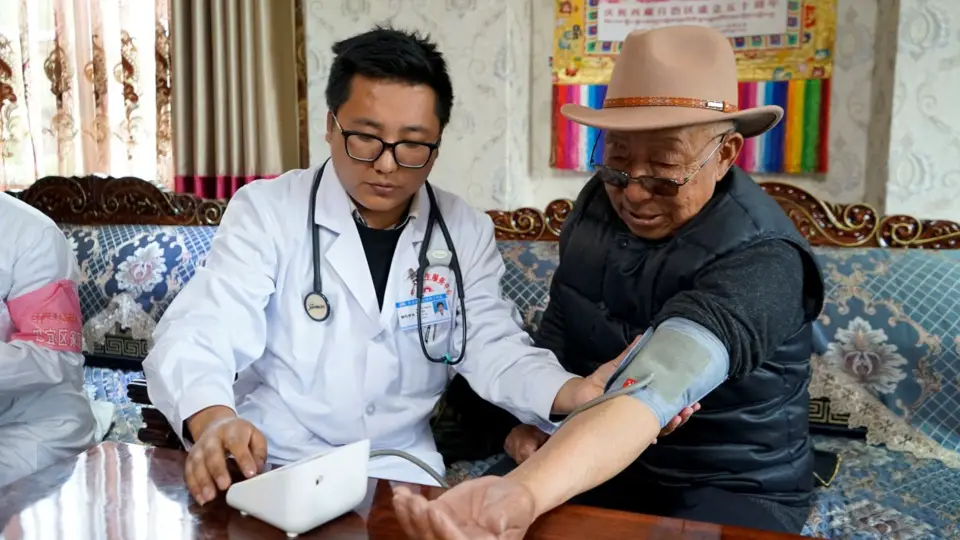By Shen Shaotie, People’s Daily

A doctor on a house call checks blood pressure and glucose for a patient in a village in Nyingchi, Tibet Autonomous Region. (By Shen Shaotie, People’s Daily)
“My life was saved by the experts from Beijing.”
Mima, a man from Lhasa, capital city of the Tibet Autonomous Region meant every word he said when expressing his gratitude.
The 45-year-old man had just had his gastric cancer cured after receiving a surgery at the Lhasa People’s Hospital performed by experts from Beijing under a medical assistance program co-launched by the Organization Department of the Communist Party of China Central Committee and the former National Health and Family Planning Commission, which is now the National Health Commission.
“Cancer” never appeared in Mima’s dictionary though he drank much regularly. He started feeling nauseous and pain in the stomach two years ago, but it didn’t trigger his attention.
In early 2019, he finally had an examination at the Lhasa People’s Hospital as the pain went intolerable. The result showed that his stomach was swelling with large area of ulcer, and he was diagnosed gastric cancer.
Mima’s wife started weeping as she learned the message, thinking there would be no cure at all.
Fortunately, the couple surprisingly found that the Lhasa People’s Hospital was able to perform a surgery to cure Mina, as the hospital has largely improved its capability thanks to the partner assistance provided by experts from Beijing through a medical assistance program.
After Liu Chuntao, an expert with the gastroenterology department of the Beijing Friendship Hospital confirmed the area for gastric resection through an intraoperative gastroscopy, the surgery was completed by several Tibetan surgeons from the Lhasa People’s Hospital under the guidance of Liu’s colleague Yin Jie, a surgical expert.
The delicate surgery, which took six and a half hours, was a rare case in the history of the Lhasa People’s Hospital.
The hypoxia at high altitude in Tibet is one of the reasons for the harsh environment in the region. In Lhasa, a city located over 3,600 meters above the sea level, the annual average oxygen concentration in the air is only 64.3 percent of that in the plains.
However, Yin joined the surgery immediately after he arrived at the hospital. According to one of the nurses at site, Yin suffered severe altitude sickness, but he kept concentrating on the surgery and completed it with an oxygen mask.
The medical assistance program was launched in June, 2015. A total of 659 medical staff had provided assistance to hospitals in Tibet by the time when the fourth batch of medical teams completed their job there.
They brought 847 advanced technological results and experiences, as well as 1,014 new medical technologies to Tibet. At present, the autonomous region is able to independently cure 338 kinds of major diseases, and 1,990 kinds of medium-level diseases can be cured in the region’s prefectures and cities.
The assisted hospitals performed nearly 20,000 surgeries rated as relatively difficult and difficult and saved the lives of over 90 percent of patients with serious illnesses or in critical condition.
With the assistance of the medical teams, Tibet has established a complete medical service network covering both urban and rural residents at district, city, county, township and village levels, introduced Wang Yunting, Party chief and deputy director of Tibet’s health commission.
Basic medical care, disease prevention and control, maternal and child health care, first-aid and touring medical services in the region have constantly improved, Wang added.
The number of medical and health institutions in the region reached 1,548, with 16,800 beds and more than 24,000 medical workers. Now every one thousand population in Tibet Autonomous Region share 4.88 beds, 5.54 health technicians, and 2.41 assistant physicians, all close to the national average.
Mima, a man from Lhasa, capital city of the Tibet Autonomous Region meant every word he said when expressing his gratitude.
The 45-year-old man had just had his gastric cancer cured after receiving a surgery at the Lhasa People’s Hospital performed by experts from Beijing under a medical assistance program co-launched by the Organization Department of the Communist Party of China Central Committee and the former National Health and Family Planning Commission, which is now the National Health Commission.
“Cancer” never appeared in Mima’s dictionary though he drank much regularly. He started feeling nauseous and pain in the stomach two years ago, but it didn’t trigger his attention.
In early 2019, he finally had an examination at the Lhasa People’s Hospital as the pain went intolerable. The result showed that his stomach was swelling with large area of ulcer, and he was diagnosed gastric cancer.
Mima’s wife started weeping as she learned the message, thinking there would be no cure at all.
Fortunately, the couple surprisingly found that the Lhasa People’s Hospital was able to perform a surgery to cure Mina, as the hospital has largely improved its capability thanks to the partner assistance provided by experts from Beijing through a medical assistance program.
After Liu Chuntao, an expert with the gastroenterology department of the Beijing Friendship Hospital confirmed the area for gastric resection through an intraoperative gastroscopy, the surgery was completed by several Tibetan surgeons from the Lhasa People’s Hospital under the guidance of Liu’s colleague Yin Jie, a surgical expert.
The delicate surgery, which took six and a half hours, was a rare case in the history of the Lhasa People’s Hospital.
The hypoxia at high altitude in Tibet is one of the reasons for the harsh environment in the region. In Lhasa, a city located over 3,600 meters above the sea level, the annual average oxygen concentration in the air is only 64.3 percent of that in the plains.
However, Yin joined the surgery immediately after he arrived at the hospital. According to one of the nurses at site, Yin suffered severe altitude sickness, but he kept concentrating on the surgery and completed it with an oxygen mask.
The medical assistance program was launched in June, 2015. A total of 659 medical staff had provided assistance to hospitals in Tibet by the time when the fourth batch of medical teams completed their job there.
They brought 847 advanced technological results and experiences, as well as 1,014 new medical technologies to Tibet. At present, the autonomous region is able to independently cure 338 kinds of major diseases, and 1,990 kinds of medium-level diseases can be cured in the region’s prefectures and cities.
The assisted hospitals performed nearly 20,000 surgeries rated as relatively difficult and difficult and saved the lives of over 90 percent of patients with serious illnesses or in critical condition.
With the assistance of the medical teams, Tibet has established a complete medical service network covering both urban and rural residents at district, city, county, township and village levels, introduced Wang Yunting, Party chief and deputy director of Tibet’s health commission.
Basic medical care, disease prevention and control, maternal and child health care, first-aid and touring medical services in the region have constantly improved, Wang added.
The number of medical and health institutions in the region reached 1,548, with 16,800 beds and more than 24,000 medical workers. Now every one thousand population in Tibet Autonomous Region share 4.88 beds, 5.54 health technicians, and 2.41 assistant physicians, all close to the national average.
 Menu
Menu
 Partner assistance program builds up medical capabilities of Tibet Autonomous Region
Partner assistance program builds up medical capabilities of Tibet Autonomous Region
















